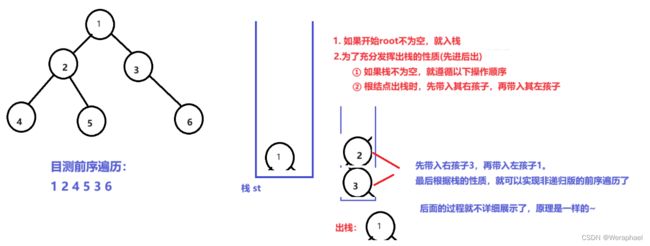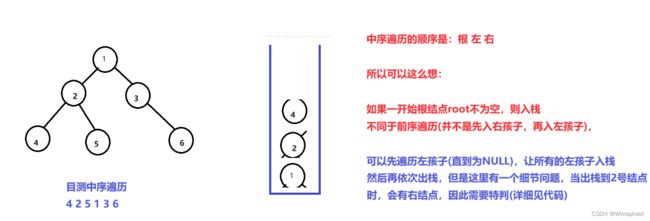【数据结构】非递归实现二叉树的前 + 中 + 后 + 层序遍历(听说面试会考?)
![]()
个人主页:@Weraphael
✍作者简介:目前学习C++和算法
✈️专栏:数据结构
希望大家多多支持,咱一起进步!
如果文章对你有帮助的话
欢迎 评论 点赞 收藏 加关注✨
目录
- 一、需要使用到的代码
-
-
- 1.1 二叉树的基本实现
- 1.2 栈
- 1.3 队列
-
- 二、非递归实现二叉树的前序遍历
-
-
- 2.1 思路
- 2.2 代码实现
-
- 三、非递归实现二叉树的前序遍历
-
-
- 3.1 思路
- 3.2 代码实现
-
- 四、后序遍历
-
-
- 4.1 思路
- 4.2 代码实现
-
- 五、层序遍历
-
-
- 5.1 思路
- 5.2 代码实现
- 5.3 整个测试结果
-
- 六、总结
一、需要使用到的代码
1.1 二叉树的基本实现
二叉树的基本实现在以往博客已经详细讨论过了,这里直接给出本篇博客的所需用到的源代码。【数据结构】二叉树的链式结构(笔记总结)
#include 在以上源代码中,我另外给出了递归实现遍历的版本,目的是为了和非递归(迭代)版进行对比。
1.2 栈
// 需要存储的数据类型是二叉树结构体的指针!
typedef BinaryTree *DataType1;
typedef struct stack
{
DataType1 *_a;
int size;
int capacity;
} stack;
void StackInit(stack *st)
{
st->_a = (DataType1 *)malloc(sizeof(DataType1) * 4); // 假设默认大小为4
if (st->_a == NULL)
{
printf("st->_a malloc failed\n");
return;
}
st->capacity = 4;
st->size = 0;
}
// 入栈
void PushStack(stack *st, DataType1 val)
{
if (st->capacity == st->size)
{
// 每次扩大两倍
DataType1 *newcapacity = (DataType1 *)realloc(st->_a, sizeof(DataType1) * 4 * 2);
if (newcapacity == NULL)
{
printf("st->_a realloc failed\n");
return;
}
st->_a = newcapacity;
st->capacity *= 2;
}
st->_a[st->size] = val;
st->size++;
}
// 判断栈是否为空
bool StackEmpty(stack *st)
{
return st->size == 0;
}
// 出栈
void PopStack(stack *st)
{
if (StackEmpty(st))
{
printf("stack is empty\n");
return;
}
st->size--;
}
// 访问栈顶元素
DataType1 StackTop(stack *st)
{
return st->_a[st->size - 1];
}
栈是后面前、中、后序遍历所需要的。但是需要注意的是:栈需要存储的数据类型是二叉树结构体的指针。为什么?在后面会详细说明。
1.3 队列
// 需要存储的数据类型是二叉树结构体的指针
typedef BinaryTree *QueueType;
typedef struct QueueNode
{
QueueType _val;
struct QueueNode *_next;
} QueueNode;
typedef struct Queue
{
QueueNode *tail;
QueueNode *head;
} Queue;
// 初始化队列
void InitQueue(Queue *q)
{
q->tail = q->head = NULL;
}
// 插入元素
void PushQueue(Queue *q, QueueType x)
{
QueueNode *newnode = (QueueNode *)malloc(sizeof(QueueNode));
if (newnode == NULL)
{
printf("newnode create failed\n");
return;
}
newnode->_next = NULL;
newnode->_val = x;
if (q->head == NULL)
{
if (q->tail != NULL)
return;
q->head = q->tail = newnode;
}
else
{
q->tail->_next = newnode;
q->tail = newnode;
}
}
// 判断队列是否为空
bool QueueEmpty(Queue *q)
{
return (q->head == NULL) && (q->tail == NULL);
}
// 队头元素
QueueType FrontQueue(Queue *q)
{
return q->head->_val;
}
// 出队列
void PopQueue(Queue *q)
{
if (QueueEmpty(q))
{
printf("Queue is empty\n");
return;
}
if (q->head->_next == NULL)
{
free(q->head);
q->head = q->tail = NULL;
}
else
{
QueueNode *next = q->head->_next;
free(q->head);
q->head = next;
}
}
队列是为层序遍历所准备的。同理地,队列存储的数据类型同样也要是二叉树结构体指针。
为了快速实现二叉树的遍历,以上栈和队列的细节代码并不完整。详细的可以参考往期博客:点击跳转
话不多说,现在进入正题!
二、非递归实现二叉树的前序遍历
2.1 思路
请看下图
最后回过头来讲讲为什么栈的存储的类型要是二叉树结构体的指针?
通过上图,我们总结了:结点出栈,需要带入其左右孩子。因此,如果不是其结构体指针,那么也就无法将root的左右孩子入栈了。注意:也不能存结构体。因为一个结构体太大了,而指针的大小只有4/8字节
2.2 代码实现
// 非递归实现前序遍历
void PreOrder_nonR(BinaryTree *root)
{
// 1. 需要一个赋值栈
stack st;
StackInit(&st);
// 2. 如果根结点不为空入栈
if (root != NULL)
{
PushStack(&st, root);
}
while (!StackEmpty(&st))
{
// 记录栈顶元素
BinaryTree *top = StackTop(&st);
// 3. 出栈后带入其左右孩子
PopStack(&st);
printf("%d ", top->_data);
// !要注意顺序:先带右孩子,再带左孩子
if (top->_right)
PushStack(&st, top->_right);
if (top->_left)
PushStack(&st, top->_left);
}
}
三、非递归实现二叉树的前序遍历
3.1 思路
请看下图
3.2 代码实现
void InOrder_nonR(BinaryTree *root)
{
// 1. 需要一个辅助栈
stack st;
StackInit(&st);
// 如果一开始根结点为NULL
// 直接返回
if (root == 0)
return;
// 2.遍历左孩子,将其全部入栈
BinaryTree *cur = root;
while (cur)
{
PushStack(&st, cur);
cur = cur->_left;
}
while (!StackEmpty(&st))
{
// 出栈打印
BinaryTree *top = StackTop(&st);
PopStack(&st);
printf("%d ", top->_data);
// 特判:出栈结点存在右孩子
if (top->_right)
{
// 将其入栈
PushStack(&st, top->_right);
// 然后还要特殊判断这个右孩子有没有左孩子
// 因为我们要保证 先左 再根 再右
BinaryTree *cur2 = top->_right;
while (cur2->_left)
{
PushStack(&st, cur2->_left);
cur2 = cur2->_left;
}
}
}
}
四、后序遍历
4.1 思路
后序遍历我就不画图了,本人一开始写非递归后序遍历写了好久,都失败了(太菜了)。直到我看到一个视频,才知道原来后序遍历这么简单!
首先可以参考前序遍历(根左右)。因此,我们只要将前序遍历的代码逻辑的遍历顺序左和右对调一下,就变成根右左,最后再对其逆序,就是左右根,也就是后序遍历的结果了
4.2 代码实现
void PostOrder_nonR(BinaryTree *root)
{
int res[6]; // 为了逆序
int i = 0; // 用于遍历res数组
memset(res, 0, sizeof(int));
stack st;
StackInit(&st);
if (root != NULL)
{
PushStack(&st, root);
}
while (!StackEmpty(&st))
{
BinaryTree *top = StackTop(&st);
PopStack(&st);
res[i++] = top->_data;
// 将前序遍历的代码逻辑的遍历顺序对调
if (top->_left)
PushStack(&st, top->_left);
if (top->_right)
PushStack(&st, top->_right);
}
// 最后逆序输出即可
for (int k = i - 1; k >= 0; k--)
{
printf("%d ", res[k]);
}
printf("\n");
}
五、层序遍历
5.1 思路
层序遍历顾名思义就是一层一层遍历,那么就不能使用栈,得使用队列。
步骤:使用一个队列,出一个结点,带入它的孩子结点
如果树不为空,就先让根结点入队列
然后出队列(打印
1),再把1的左孩子和右孩子带入队列
接着让
2出队列,再把2的孩子入队列
同理,再让
4出队列,把它的孩子入队列
最后如果队列为空,即完成层序遍历
5.2 代码实现
void LevelOrder(BinaryTree *root)
{
// 1. 需要辅助队列
Queue q;
InitQueue(&q);
// 如果一开始根结点root不为空
// 则入队列
if (root != NULL)
PushQueue(&q, root);
// 然后出双亲结点,带入子结点
while (!QueueEmpty(&q))
{
BinaryTree *front = FrontQueue(&q);
PopQueue(&q);
printf("%d ", front->_data);
// 带入子结点
if (front->_left)
PushQueue(&q, front->_left);
if (front->_right)
PushQueue(&q, front->_right);
}
}
5.3 整个测试结果
六、总结
对于数据结构,还是得建议多画画图。最后我不将所有的代码整合到一块,读者只需理解,最好自己实现一遍。


